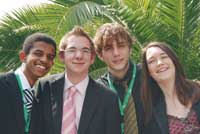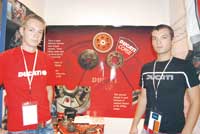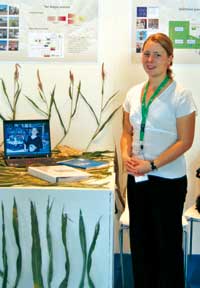Welcome to Valencia! The EU Contest for Young Scientists Inspire article
Anne MJG Piret from the European Commission assisted the jury during the recent EU Contest for Young Scientists.

Abubakar, Florian Ostermaier,
Márton Spohn and Henrike Wilms
Image courtesy of the European
Commission
The golden voice of Empar, one of the leaders of the student helpers, resonates through the enormous exhibition hall of the Prince Felipe Science Museum in Valencia, Spain. The venue is impressive. Shouts of “Portugal, over here please!” and “Belarus, this way!” echo through the hall.
The contestants at the European Union (EU) Contest for Young Scientists, hailing from across Europe and beyond, follow their student leader to their reserved spots.

Czech Republic
Image courtesy of the European
Commission
The contest begins! It is up to the contestants to prepare their booths and present their projects.
Josef and Tomáš, from the Czech Republic, put their posters up and create a booth featuring a special type of clutch for the motorcycle manufacturer Ducati. Angel from Spain turns his booth into a real Pantheon, including a model of the original building and a lamp as a substitute for the Sun.
Martina from Austria carefully decorates her booth with maize straw. Her environmental science project, ‘Energy from maize straw’, will later be awarded second prize, but at this stage her main concern is to make sure she presents her material effectively when the judges start their interviewing rounds.

Image courtesy of the European
Commission
At two o’clock, the jury rounds start. The 15 members of the jury have already read the project descriptions and discussed them in a meeting in Brussels. Now they have the opportunity to interview the youngsters and ask them how they conducted their research, why they conducted it in the way they did, as well as how they chose their topic.
The young scientists are nervous, but at the same time eager to present their projects.
They have been working on them for a long time, and have already won the national contest in their home country. What the contestants don’t know, is that the jury members are almost as nervous as they are, and eager to meet these talented young people whose projects they have so far assessed only on paper.
Having fun!
At five o’clock, the jury members return from their first day’s round of interviews, exhausted but very excited. The enthusiasm of the young scientists is contagious and the new jury members have difficulties disconnecting and preparing for an evening of entertainment. The contestants are better able to switch off, and together with the Spanish student helpers will show them how to set aside their stress – over a paella evening organised by their hosts.
Meeting real scientists
It has become a tradition in the EU Contest for Young Scientists to invite renowned scientists to meet and talk to the contestants. This year the European Commission also chose to invite scientists who are at the beginning of their careers, so they could provide an insight into their career paths and experiences of working as a young scientist.
EIROforumw1 (the publishers of Science in School) sent Freya Blekman, who works at CERNw2. As a school ambassador for the EU-funded SET-Routesw3 project and an official CERN guide, Freya is clearly used to talking to non-specialists and students about science. Her lecture on the importance of particle physics and the role that a young scientist can play within the frame of an important scientific organisation such as CERN not only received very positive reactions, but also triggered a lot of enthusiasm amongst the young (and not so young) people in the audience!
The rewards
Another bright, sunny day greets the last day of the EU Contest for Young Scientists 2007 as everyone makes their way to hear the winners announced. The dolphins in the oceanographic museum seem almost as enthusiastic as the young people watching them. For a moment, the contestants forget the awards ceremony and their stress and enjoy their surroundings.
The final decisions were made the evening before, when the jury had the exceptionally difficult task of deciding on the winners of the cash prizes, the honorary awards and the special donated prizes. But ultimately, as in every competition, winners must be appointed, and the most outstanding projects were chosen from amongst 81 entries in a wide range of disciplines such as biology, chemistry, environmental science, social sciences, physics, molecular biology and engineering.
The master of ceremonies seems as nervous as the contestants. The press is pushing at all sides to find the best position for taking photographs of the winners and we are all very excited!
Finally, the winners are announced (see box ‘Some of the winning projects’). Some of the young scientists are visibly astonished. Some are surprisingly at ease in front of the cameras, others burst into tears of joy and fall into each others’ arms, but all of them are clearly overjoyed with their prizes.
The 19th EU Contest for Young Scientists is over, but for many of the young scientists participating in this event, it will remain much more than a competition. Many of them learned to work in a team, became interested in other fields of science and made new friends. For all of the contestants, the EU Contest is undoubtedly an unforgettable and rewarding experience.
What is the EU Contest for Young Scientists?
The EU Contest for Young Scientists is a high-profile event, open to young people aged between 14 and 21, who are the winners of national competitions. The contest gives these students the opportunity to compete with the best of their contemporaries at a European level. Although the demand for scientists and researchers is rising, the number of young people taking up scientific studies and careers is dipping. The organisation of events that mobilise young people from all over Europe and beyond is thus more important than ever.
The contest also gives Europe’s best young scientific brains a forum to display their wares and connect with other like-minded students from other countries. It aims at rewarding scientific achievement and demonstrating to a wider audience that science is fun. Besides being an occasion for nurturing talent and enhancing young people’s scientific and technological skills, it is also an opportunity for these young scientists to meet other youngsters with similar abilities and interests, but from a different country and perhaps speaking another language, and to be guided by some of the most prominent scientists in Europe.
How are projects chosen for the EU Contest for Young Scientists?
Only projects that have won a top prize at a national young scientist competition can participate in the EU Contest for Young Scientists. Project entries from all fields of scientific endeavour are accepted.
National competition organisers are responsible for selecting the projects and submitting the applications, and for all communication with the European Commission. Each participating country has an assigned national organiser who manages all applicants from their country. A list of the national organisers is available on the EU Contest for Young Scientists websitew4.
What constitutes a project?
Each project must consist of a technical written report, display materials and models. A group of up to six contestants may submit a project and each country may enter up to three projects. During the contest, the participants must set up their project on a display stand and are required to answer questions from members of the scientific jury. The science exhibition is open to the public.
Some of the winning projects
The first prize was awarded jointly to three projects, from Germany, Hungary and Ireland.
Country: Germany
Contestants: Florian Ostermaier (19), Henrike Wilms (20)
Field: Physics
Project title: Flashing Water Drops
Visiting a stalactite cave last summer, one of us made a strange observation: Every time a drop fell down from the top it seemed as if it would flash at a certain height. We didn’t know the explanation for this, so we tried to reproduce the phenomenon at home. Our first idea was to use the drops falling down from the water tap. Quite accidentally, we found out that the effect only occurred when we put a light source in a very special position, shining towards the observer and the falling drop. Fascinated by this mystery, we started doing some research on the strange flash in the air. During our work we found out the relevant factors and we can know exactly under which conditions these flashes occur. In addition to that we succeeded in describing the phenomenon mathematically and we know now that the light reflections within a falling droplet change because the droplet itself oscillates. We also found out that this can be observed in any case where a drop detaches from anything, such as in the shower, at a water tap or when raindrops fall from gutters. With our research we found a completely new phenomenon that, as far as we know, has never been analysed.
Country: Hungary
Contestant: Márton Spohn (18)
Field: Chemistry
Project title: Examination of the Plants’ Self-Defence Against Pests
Some plants, especially members of the mint family, can defend themselves against pests in a special manner: they emit scents that attract natural predators of the pests. This phenomenon was studied by biologists and chemists, but a contradiction remained unnoticed: chemicals directly responsible for this effect cannot evaporate. My project was aimed at finding the reaction pathways taking place in the plant during an attack to convert the furanoterpenoids (chemicals responsible for self-defence) into volatile compounds. Experiments were made with plant extracts which mainly involved chromatographic methods to discover possible pathways. The experiment-based effect mechanism model of furanoterpenoids can explain the rapid reaction of the plant to an attack despite the fact that furanoterpenoid is produced very slowly. By discovering more details of floral self-defence, more environmentally friendly pesticides may be developed.
Country: Ireland
Contestant: Abdusalam Abubakar (16)
Field: Mathematics
Project title: An Extension of Wiener’s Attack on RSA Encryption
In 1990, Michael J. Wiener showed that if RSA (an algorithm for public-key cryptography) is used with a small decryption exponent, it can be successfully attacked. He based his attack on the properties of continued fractions, in particular on a very well known theorem of Legendre concerning the approximation of irrational numbers by simple continued fractions. In 2004, MJ Hinek proved that if a very large decryption exponent is used, the RSA system can be successfully attacked. Using a small decryption exponent, d, has the advantage of allowing rapid decipherment. It might be thought that this advantage could be retained by increasing d just beyond the range vulnerable to Wiener’s attack. In attacks of the Wiener and Hinek types the condition must be obeyed for the success of the attack to be guaranteed. I shall refer to this condition as the ‘n1/4 barrier’. In this project I investigate attacks beyond the n1/4 barrier. My project builds on Andrej Dujella’s work. I generalise Dujella’s inequality and I prove a number of theorems related to his extension of Legendre’s theorem that form the mathematical basis for efficient Wiener- and Hinek-type attacks beyond the n1/4barrier.
EIROforum prizes
The seven European intergovernmental research organisations that make up EIROforum also awarded prizes: a one-week visit to the respective research organisation.
CERN: The European Organization for Nuclear Research
Country: United Kingdom
Contestant: Galen Brown (17)
Field: Engineering
Project title: FSC11 – The flexible TV standby controller
EFDA: The European Fusion Development Agreement
Country: Turkey
Contestant: Mustafa Taghiyev (16)
Field: Mathematics
Project title: The Integer Values Of Algebraic Expressions And Some New Properties Of Binomial Coefficients
EMBL: The European Molecular Biology Laboratory
Country: Austria
Contestant: Philipp Zagar (18)
Field: Chemistry
Project title: Synthesis of a linker molecule for self-assembled monolayers (SAM)
ESA: The European Space Agency
Country: Germany
Contestant: Raphael Errani (17)
Field: Physics (Astronomy)
Project title: Impact Probability of Asteroids on Earth
ESO: The European Organisation for Astronomical Research in the Southern Hemisphere
Country: Slovakia
Contestant: Ľubomír Urbančok (17)
Field: Physics (Astronomy)
Project title: The study of symbiotic star BF Cygni
ILL: The Institut Laue-Langevin and ESRF: The European Synchrotron Radiation Facility
Country: Lithuania
Contestants: Milda Jurénaité (19) and Rasa Briedyté (19)
Field: Chemistry
Project title: Zinc and zinc alloy galvanic coatings: structure homogeneity determines resistance to corrosion
The background to the contest
For the past two decades, the EU, via its framework programmes, has supported science and technology and encouraged co-operation between European researchers. The EU also recognises the need to start the process of integration at the grass-roots level. The European Commission actively supports young people’s interest in science and promotes European co-operation in the fields of education and training.
To meet the objective of the European Research Area – to co-ordinate national research policies in the direction of shared objectives, expertise and resources – the heads of state and government have confirmed a need to increase the global expenditure on research to 3% of gross national product – or one and a half times the current level – by 2010. This substantial increase will enable Europe to bridge the gap with the United States and Japan and help create a uniform concept of European research similar to the single European market.
The EU Contest for Young Scientists plays an essential role in the development of a pan-European scientific community. Over the years it has generated excitement and has gone some way to popularising science among the young.
Web References
- w1 – EIROforum, which publishes Science in School, is a partnership of Europe’s seven largest intergovernmental research organisations. See www.eiroforum.org
- w2 – CERN is the world’s largest particle physics laboratory. See www.cern.ch
- w3 – The SET-Routes project aims to encourage more girls and women to study science, engineering and technology and to help them further their careers. As part of the ambassador programme, young female scientists visit schools and universities. For more details, see www.set-routes.org
- w4 – For more information on the EU Contest for Young Scientists in general and the 2007 contest in Valencia, see http://ec.europa.eu/research/youngscientists
Institutions






